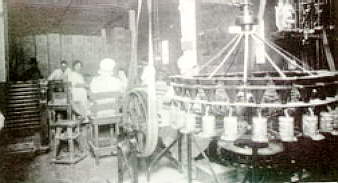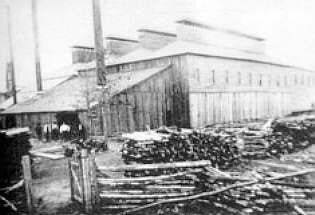Another method of salt production used by Morton Salt is the evaporation of salt brine by steam heat in large commercial evaporators. This method yields a very high purity salt. Fine in texture, and principally used in those applications where quality is of first importance.
The first part of the operation is known as solution mining. Two wells are sunk 500 to 1,000 feet apart into the salt vein. Water is forced down one well under great pressure. It seeks the easiest way out, namely up the other well. Once the two wells are connected, the operation begins. Water is pumped down one well. The salt below is dissolved. The resulting salt brine is forced to the surface through the other well. It then goes into huge tanks for storage.
Next the brine is pumped into the vacuum pans. These are huge closed vessels about three stories high, and normally in a series of three, four or five with each one in the line under greater vacuum than the preceding one. This series of vacuum pans operates on a very simple principle: whenever pressure is lowered, the temperature at which water will boil is also lowered. For instance, under normal air pressure at sea level, water boils at 212 degrees F. But at ten thousand feet above sea level, where air pressure is much less, water boils at 194 degrees F.
In the vacuum pan process steam is fed to the first pan. This causes the brine in the pan to boil. The steam from the boiling brine is then used to heat the brine in the second pan. The pressure in the second pan is lower, allowing the steam made by the boiling in the first pan to boil the brine in the second pan.
The pressure is reduced still further in each succeeding pan. This allows the steam made by the boiling brine in the previous pan to boil the brine in the next pan. The boiling operation could be done with just one pan. Several pans in a row produce more salt per pound of steam, allowing energy efficiency.
The heating of brine actually takes place in the middle section of the vacuum pan. Two large metal sheets act as a top and bottom of this section. They are connected by hundreds of copper tubes through which the brine can flow freely between top and bottom. This is known as a calandria pan. The pan is filled with brine to just above the top of the tubes. Steam is fed around the tubes, hot enough to keep the brine boiling.
In most pans, the brine goes up through the tubes and down through the well in the center. There an agitator and natural circulation keep it flowing. Vigorously boiled and agitated brine produces salt in the shape of small cubes. The salt settles continuously into the narrow bottom of the pan. Here it is pulled off as slurry. That means a mixture of brine and salt. The slurry goes from the vacuum pans to the filter dryer where heating removes the moisture and dries the salt.
For salt going into table salt packages, coarse grades and extra fine grades are removed by screening. Only uniformly sized, cube-shaped salt remains. To this salt is added a small quantity of coating material, sodium silico aluminate, to keep the salt free-flowing in damp weather. Hence the famous Morton slogan, "When It Rains It Pours."
Other than Grand Saline evaporated facilities are located at Newark, California; Hutchinson, Kansas; Weeks Island, Louisiana; Mainstee, Michigan, Marysville, Michigan; Silver Springs, New York and Rittman, Ohio.
Evaporated salt is used for table salt, food processing, high quality chemical uses, and water softening.
The photos on this page were furnished by the Van Zandt County Historical Commission, republished with their permission from The Pictorial History of Van Zandt County 1848-1994. Additions, corrections, comments, complaints and compliments concerning this page should be submitted to Billy & Carla Clifton.

